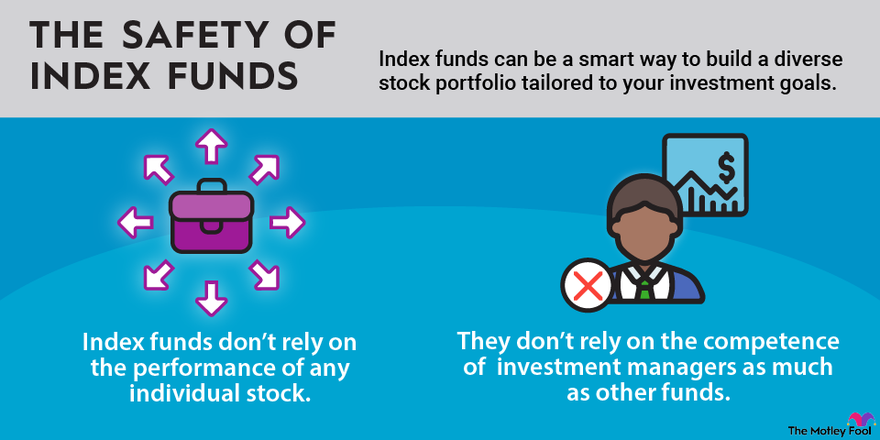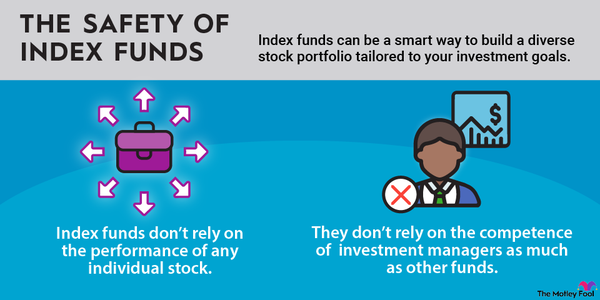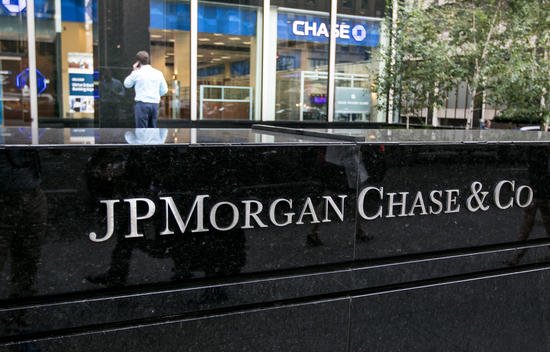Index funds can be an excellent way to build an investment portfolio that isn’t too dependent on the success of any particular stock or bond. But not all index funds are in the “safe” category. In this article, we’ll dive into nine top index funds that should hold up well during turbulent times while still delivering strong long-term performance — no matter what the economy does.
Before we go on, none of these are completely safe, especially over short time periods. However, these index funds offer an excellent combination of growth potential and long-term safety.

Image source: The Motley Fool.
9 Safest Index Funds and ETFs
Nine of the safest Index Funds and ETFs to buy in 2025
There are plenty of index funds to invest in, but some are much safer than others. Some deliver fantastic long-term returns no matter what the economy, political climate, or stock market does in the short run. Others hold up better during recessions and other periods of uncertainty. By incorporating index funds like the nine exchange-traded funds (ETFs) listed here into your portfolio, you can implement a well-rounded investment strategy that can help you build wealth and sleep soundly at night.
1 – 5
1. Vanguard S&P 500 ETF
Legendary investor Warren Buffett has said that the best investment the average American can make is a low-cost S&P 500 index fund like the Vanguard S&P 500 ETF (VOO 1.81%).
As its name implies, the ETF invests in all 500 companies that make up the S&P 500 large-cap benchmark index and aims to track the performance of the index over time. It has a rock-bottom 0.03% expense ratio, which means your annual investment fees will be just $0.30 for every $1,000 in fund assets.
For all of these funds, note that an expense ratio isn’t a fee you have to pay. It will simply be reflected in the index fund’s performance over time.
To be sure, the S&P 500 isn’t necessarily a “safe” investment over short periods of time. The index has historically fallen by 20% or more from recent highs every few years, and it happened as recently as the 2022 bear market. However, over time, you might be surprised by how consistent the performance of the S&P 500 has been. From 1965 through the end of 2024, the S&P 500 delivered annualized total returns of 10.4%, and performance like this can build tremendous wealth over long periods.
2. Vanguard High Dividend Yield ETF
The Vanguard High Dividend Yield ETF (VYM 1.55%) tracks an index of stocks that have above-average dividend yields. The fund has a 0.06% expense ratio and invests in 530 different stocks, with top holdings including Broadcom (AVGO 5.42%), Walmart (WMT 2.42%), ExxonMobil (XOM 3.05%), and JPMorgan Chase (JPM 4.02%). As you might expect, the ETF has an above-average 2.7% dividend yield.
As a group, dividend-paying stocks tend to hold up better than their non-dividend counterparts during tough times; that’s exactly what we saw during the most recent bear market.
This doesn’t come at the expense of long-term performance. The dividend-focused ETF tends to outperform during tough times and underperform during bull markets, but dividend stocks have historically delivered about the same total returns as the S&P 500 over time. In a nutshell, the ETF can be a great option for investors who want strong long-term performance but with less short-term volatility than the overall market.
3. Vanguard Real Estate ETF
Real estate investment trusts, or REITs, can be a great addition to any risk-averse investment portfolio. REITs tend to pay higher dividends than the typical S&P 500 stock, have lower volatility during difficult environments, and have actually outperformed the S&P slightly over the long run.
The Vanguard Real Estate ETF (VNQ 1.21%) tracks a weighted index of 156 REITs, with top holdings that include American Tower (AMT 3.23%), Prologis (PLD 1.31%), Crown Castle (CCI 1.52%), Equinix (EQIX 0.85%), and Welltower (WELL 0.59%), just to name a few. Because REITs are designed to pass through most of their income to shareholders, the fund pays a dividend yield of about 3.7% as of March 2025. Its 0.13% expense ratio is on the lower end of the ETF spectrum, so you’ll keep most of the returns the underlying stocks generate.
4. iShares Core S&P Total U.S. Stock Market ETF
Instead of choosing individual stocks or even a particular benchmark index, one way to reduce your risk is to simply invest in the entire stock market. You can do this by investing in an index fund that tracks a “total market” index, such as the iShares Core S&P Total U.S. Stock Market ETF. (ITOT 1.73%) To be sure, the overall market can be quite volatile in the short term but has historically produced excellent long-term returns.
As the name suggests, the ETF essentially aims to match the performance of the overall U.S. stock market. It owns almost 2,500 different stocks, ranging from mega-cap giants to small-cap companies. Its 0.03% expense ratio is among the lowest in the entire ETF industry.
5. Consumer Staples Select Sector SPDR Fund
If you’re concerned about safety during a recession or other tough environments, it can be a good idea to invest in companies that sell things that people need. The consumer staples sector is full of companies that do just that, and a great index fund to invest in is the Consumer Staples Select Sector SPDR ETF (XLP 1.3%).
The ETF has a 0.08% expense ratio, which is certainly on the lower end of the spectrum when it comes to sector-specific index funds. It invests in the consumer staples companies in the S&P 500 index, with larger holdings in companies such as Costco (COST -0.11%), Procter & Gamble (PG 2.08%), Walmart, and Coca-Cola (KO 0.82%). In a nutshell, these businesses tend to do almost as well in tough economic times as they do in strong economies.
6 – 9
6. iShares 0-3 Month Treasury Bond ETF
When it comes to safe investments, the iShares 0-3 Month Treasury Bond ETF (SGOV 0.04%) is the next safest thing to simply holding cash in your portfolio. The index fund invests in a portfolio of Treasury securities with maturity dates of three months or less.
As you might imagine, this is more of a cash alternative than a way to generate wealth over the long run. Treasury securities are perfectly safe, and the short maturity nature of the fund means that your investment won’t fluctuate as much with interest rate changes as comparable ETFs of longer-maturity bonds.
The fund currently has a yield of about 4.99% due to the current interest rate environment, but this will change regularly as interest rates move higher or lower. Its 0.09% net expense ratio makes the ETF a far more appealing way to put your cash to work in a risk-free manner than actually buying bonds.
7. Vanguard Utilities ETF
There are few types of businesses as recession-resistant as utilities. Consumers and businesses need to pay their electric and gas bills no matter what the economy is doing, and these businesses generally have monopolies (or close to it) in the areas where they operate. So, an index fund like the Vanguard Utilities ETF (VPU 1.26%) that tracks the utility sector could be worth a look if safety is what you’re after.
This particular index fund has a 0.09% expense ratio, which is cheap for a sector-tracking ETF, and it owns a basket of 69 utilities stocks with a median market cap of almost $42 billion. Top holdings include NextEra Energy (NEE -1.51%), Constellation Energy (CEG 1.66%), Duke Energy (DUK 1.69%), and Southern Co. (SO 1.03%). It’s quite possible that if you own or rent a home in the United States, you make regular utility payments to a company included in the index.
It’s also worth noting that since utilities companies don’t need a ton of capital to invest in things like research and development, they tend to pay higher dividends. As of March 2025, the Vanguard Utilities ETF had a dividend yield of about 2.9%, making it a good choice for income as well as safety.
8. iShares U.S. Healthcare Providers ETF
Another sector that is typically considered to be recession-resistant is healthcare, but it’s important to realize that the healthcare sector is a broad one that contains several types of stocks that aren’t necessarily safe, such as pharmaceuticals and biotechnology companies.
For this reason, investors looking for safety may want to take a more targeted approach, such as the iShares U.S. Healthcare Providers ETF (IHF 0.98%). Instead of focusing on the entire healthcare sector, the index fund tracks a group of stocks that provide healthcare, diagnostics, and health insurance — the things people need regardless of the economic environment.
The fund has a 0.40% expense ratio, which is the highest on this list by a significant margin, but it is in line with many other specialized ETFs. (As a general rule, the narrower an index fund’s focus, the higher the fees.) The larger holdings of the ETF include UnitedHealth (UNH 0.78%) and Elevance Health (ELV 0.79%), and the index fund holds 66 healthcare provider stocks altogether.
9. Schwab U.S. TIPS ETF
Inflation spiked to its highest level in more than 40 years in 2022 and hadn’t completely cooled off as of early 2025. Keeping money in cash isn’t appealing in such an environment since inflation can dramatically erode the purchasing power of money over time.
In the interest of safely combating inflation, one ETF worth a look is the Schwab U.S. TIPS ETF (SCHP -0.04%), which invests in an index linked to inflation-protected Treasury securities. Not surprisingly, the current yield on the fund is fantastic since it’s linked to inflation. As of March 2025, the trailing-12-month yield of the ETF was around 3.0%. Be aware that if inflation cools off, the index fund will have a lower yield; if it doesn’t, the purchasing power of your money is safe. A 0.03% expense ratio can be a small price to pay for the peace of mind inflation resistance can provide.
Why are they safe?
Why are index funds considered a safe investment?
Index funds are generally considered safe because they don’t rely too much on the performance of any individual stock. They also don’t rely on the competence of investment managers as actively managed mutual funds or hedge funds do. This can add an element of safety to a volatile investment. For example, if you’re a fan of the biotech industry, choosing a biotech index fund to bet on the entire industry instead of putting your faith in a single company could be a smart way to go.
Related investing topics
The bottom line
Index funds can be a smart way to build a diverse stock portfolio tailored to your investment goals, whether your priorities are income, growth, stability, or a combination of the three. While this isn’t intended to be an exhaustive list of the index funds that could add an element of safety to your investment strategy, these are nine examples of excellent index fund ETFs that could be a great start.







